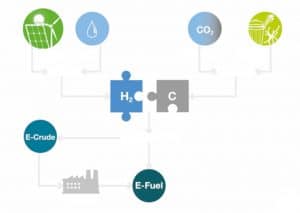The member companies of the German Petroleum Industry Association (MWV) welcome the Paris Climate Protection Agreement and the associated targets to reduce greenhouse gas emissions in all sectors. The petroleum industry can make a significant contribution to achieving the targets with renewable fuels.
At the European level, European refining companies published their concept for achieving climate targets last spring: In April 2018 the European petroleum association FuelsEurope presented its VISION 2050 [1] to the Council of EU Economic and Energy Ministers. The core is the transition to the production of low-greenhouse gas or greenhouse gas-neutral liquid energy sources and a continuous reduction in emissions from refineries. Hydrogen plays an important role here.
Numerous studies and analyses confirm that liquid energy sources and raw materials are also needed in substantial quantities in the long term. The transport sector plays a major role in this. Today – including the railways – 98 percent of the final energy demand in transport is covered by liquid energy sources. This figure alone makes it clear that with an electrification strategy alone neither the ambitious sector target of 40 percent greenhouse gas reduction in the transport sector by 2030 nor the climate targets for 2050 as a whole can be achieved.
Increasing efficiency and electrification are not enough
The analyses carried out within the framework of the National Platform on the Future of Mobility have also shown that it is not enough to rely solely on increasing efficiency, electrifying and expanding public transport, especially rail transport. Even if it is possible to bring around ten million electrically powered passenger cars and a significant number of electrically powered commercial vehicles onto the roads by 2030 and to cope with considerable growth in freight and passenger transport by rail, a share of around 20 percent renewable fuels will be needed in 2030 to achieve the 40 percent target.
The development and market ramp-up of renewable fuels is therefore a necessary measure to achieve the climate targets. Various climate-friendly technologies are available for this purpose:
…
read more in H2-international October 2019
Author:
Prof. Christian Küchen
Mineralölwirtschaftsverband (MWV), Berlin

























0 Comments